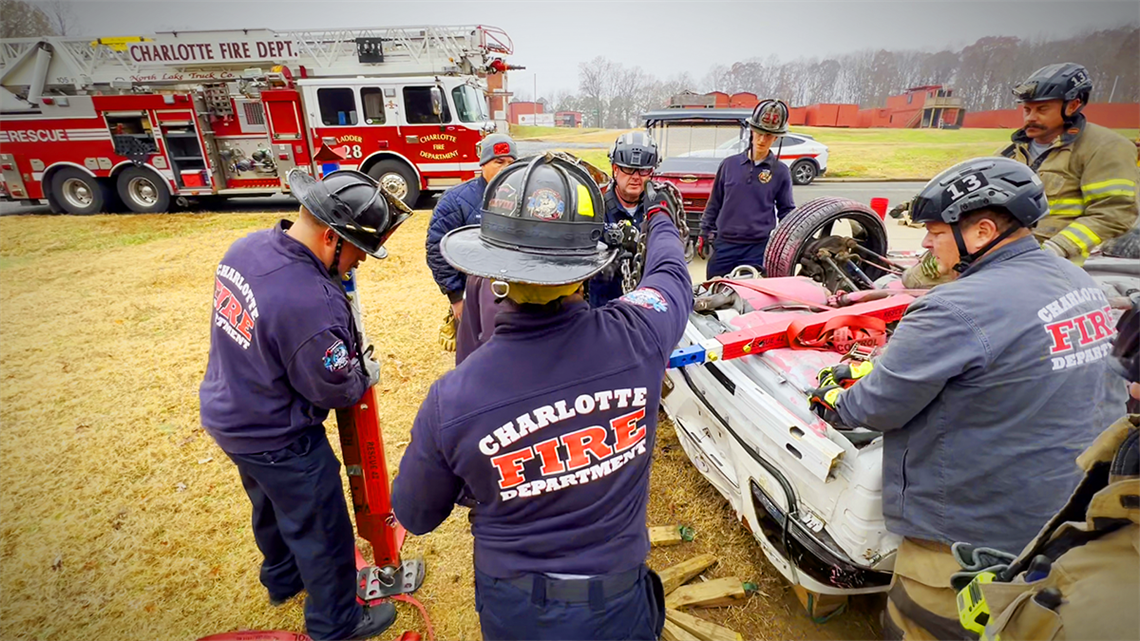Mastering Every Challenge: Inside Charlotte Fire's Special Training
Published on January 02, 2025

Charlotte firefighters work together to secure an overturned vehicle using Rescue 42 struts during a ladder company training session. This exercise highlights the importance of teamwork and precision in real-world rescue scenarios.
By Kevin Campbell, Charlotte Fire
Charlotte Fire Department’s Ladder Company Training program stands as a testament to the department’s commitment to being an all-hazards resource for the community. For Captain Kevin Newell, a training officer with Charlotte Fire, the program is about more than just skills; it’s about preparedness, innovation, and teamwork in serving a growing and dynamic city.
“Ladder companies have to be proficient at several different factors,” said Newell. “From road rescues and extrication to our core firefighting duties, the range of skills required demands consistent and advanced training.”

Charlotte Fire Ladder Company member observes a stabilization exercise during a rigorous training session focused on advanced rescue techniques.
This month-long training initiative brings crews together for specialized instruction on critical rescue techniques. One of the highlights is the use of Rescue 42 struts—a cutting-edge stabilization tool—designed to secure vehicles in precarious situations, including overturned or side-resting vehicles.
“We’ve reviewed everything from basic stabilization techniques, such as placing step chocks under a vehicle, to more advanced methods involving crib towers and understanding weight and height limitations,” Newell explained. “The Rescue 42 struts expand those capabilities, allowing us to stabilize vehicles at greater heights and even lift them safely.”

Captain Kevin Newell, a training officer, oversees ladder company crews as they refine their stabilization and rescue skills.
Bridging Knowledge Gaps
For seasoned firefighters, the training offers a mix of refreshers and novel techniques.
“Some of these firefighters have been with the department for years but have limited exposure to ladder-specific training. This program brings them up to speed and ensures they are ready for the unique challenges ladder companies face,” Newell said.

Firefighters engage in hands-on vehicle stabilization training, working together to secure an overturned car.
One observer noted the enthusiasm among participants, many of whom captured moments on their phones. “I’ve never seen anything like this,” remarked one firefighter. The training offered fresh approaches to familiar challenges, encouraging participants to think critically and adopt new strategies to improve their skills. “The Rescue 42 struts and the hands-on focus really opened my eyes to new possibilities for stabilization and rescue operations.”

Captain Brian Benson of Ladder 16 leads his team through vehicle extrication exercises, emphasizing safety and efficiency.
Newell acknowledged that even with years of experience, there is always room to learn. “The basics of stabilization and extrication haven’t changed much over the years, but advancements in technology have refined how we approach these tasks. Our priority remains safety for both our firefighters and the patients they rescue.”
Beyond Fighting Fires
Charlotte Fire is known for more than extinguishing flames. The department’s ladder companies are often called to handle complex rescues, ranging from extrications in high-traffic areas to technical rope rescues in construction zones.

Crews utilize advanced rope rescue techniques, including aerial ladder anchors, to prepare for high-angle and confined space rescues.
“We’re a one-stop shop for just about any problem,” Newell said. “Our crews are equipped to respond to situations like rescuing a construction worker from an elevator shaft or retrieving someone who has fallen into a pit. Using our aerial ladders as high-directional anchors, we can go up and over obstacles to safely lower personnel for rescues.”
This adaptability is crucial in a city with a high volume of traffic and densely populated infrastructure. Vehicle accidents are a common call for Charlotte Fire, and the training ensures firefighters are ready to respond effectively and safely.

Firefighter Joseph Hazen reviews safety protocols with his crew, ensuring effective execution of the day’s advanced rescue techniques.
“Stabilization is critical,” Newell emphasized. “You can’t perform an extrication safely without ensuring the vehicle is secure. It’s the foundation of everything we do in these scenarios.”
Crew Cohesion Through Training
One of the most significant benefits of the program is its focus on teamwork. By limiting each session to individual ladder companies, crews get dedicated time to work together and hone their skills.
“The one-on-one nature of this training allows crews to function cohesively without the distractions of multiple companies working simultaneously,” Newell said. “It’s individualized training that makes them better as a team.”

Captain Justin Miller supervises his team’s setup of a high-directional anchor system, a vital component of urban rescue operations.
The positive feedback has been overwhelming, with participants expressing appreciation for the hands-on experience. “It’s been rewarding to see the crews fully engaged and taking away valuable skills they can apply in the field,” Newell said.
“Training is the backbone of our success and the safety of our community,” said Fire Chief Reginald Johnson. “This program ensures our firefighters are equipped with the knowledge and skills to face any situation with confidence and precision. It’s a reflection of our unwavering commitment to excellence and the trust the community places in us every day.”

Engineer Ferney Mercado from Ladder 16 evaluates vehicle positioning as part of the stabilization training exercises.
A Commitment to Excellence
Charlotte Fire’s dedication to comprehensive training reflects its role as an all-hazards responder for the community. By investing in programs like Ladder Company Training, the department ensures its personnel are prepared to tackle a wide range of emergencies with professionalism and precision. For Captain Newell and his colleagues, it’s all part of the job.
“We’re here to serve,” Newell said. “Whether it’s fighting fires, performing rescues, or responding to motor vehicle accidents, our goal is to be ready for whatever the community needs.”
This commitment to excellence underscores why Charlotte Fire continues to be a trusted and vital resource for the residents of Charlotte. Through continuous training and innovation, the department sets a high standard for emergency response—one ladder company at a time.

Engineer George Alexander and Firefighter Raekwon Byrd from Tower 27 collaborate to secure rescue equipment during ladder company training.